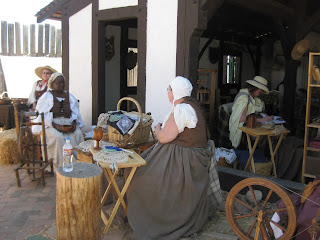Our Clue 6 completes the Egyptian leg of the trip. This is one of my favorite clues (I say that with all clues though!) because the Ladybug stitch (in our case, Scarab stitch) is such an elegant simple stitch, with such stunning results. Above in the photo is one of the test swatches I used for the pyramids, this one done in broken twisted rib. Your finished clue will have a view of the three overlapping pyramids - Khufu, Khafre and Menkaure, framed by the little scarabs. The interesting thing is that when you look at the finished clue, particularly in the square shawl, the final effect is quite different and very interesting. I would say this two clues give you a big bang for your buck.
Some of you had questions about whether or not to purl or to twist the WS/even rows of your shawl. The answer is, there is no right or wrong way to do it! If you are lagging behind in clue 5 and want a better idea of what to do, I made this little swatch:
Bottom: Twisted Rib stitch
R1 and 2: k1-tbl, p1-tbl repeated to the end
Middle: Half Twisted Rib stitch
R1: k1-tbl, p1
R2: k1, p1
Top: Broken Twisted Rib stitch
R1: k1-tbl, p1
R2: p all
As you can see, there are different levels of definition in the rib and an overall different feel with very little variation in the technique. For yarns that are darker and won't show the definition as well, you can just work a broken rib. Lighter yarns with sharper definition will show better in full twisted rib, but it really comes down to your own personal taste
This is a blocked sample; In the unblocked sample, twisted rib is a rather compact stitch and tends to pull the fabric, so you may have now a puckered appearance of the fabric. This will block nicely, opening the rib.
Super Swatch Hat
I received on the mail my order for MadTosh vintage in Cove color - a delightful blend of green-blues and browns that really make you think of a quiet cove with shallow waters.
And I have my Super Swatch started, and almost at the point where I need to decide on decreases to turn it into a hat
This is just the most lovely, squishiest yarn for cable knitting!
And I am happy to report that my original swatch measurement estimations were rather accurate. So the next step will be to write out the pattern with stitch counts and center the motifs, and I will be on my way to starting the actual coat. But first, I need to finish the hat.
Oliving la vida loca
What do you get when you mix a centennial olive tree and the balmy Arizona winter?
A backyard littered with several pounds of ripe, oily fruits every day
A really dirty child who loves to squish ripe olives
A stupid Border Collie obsessed with fetching the falling olives
And never ending pool cleaning fun for the husband!
Wyoming anybody?
It sounds like I will be going to Wheatland, WY for a few days in June for some training sessions. The place is just uninteresting enough that I won't be dragging the family, so that is me alone for the first time since the baby was born. Aside from a lot of knitting, I don't know what I am going to do with myself!
If any of you are from that area and want to point me in the direction of a nice yarn store, or just want to get together for a knit-in, give me a holler!











































